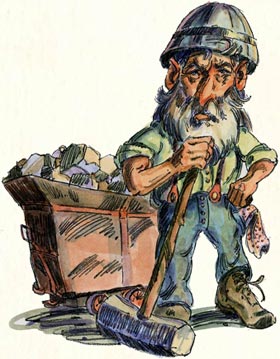(New page: '''Knockers''' are a variety of kobolds that live in mines in Welsh and Cornish folklore. ==Family== *Also called Knackers, Bwca (Welsh), Bucca (Cornish) or Tommyknockers (US), they ar...) |
|||
| Line 1: | Line 1: | ||
'''Knockers''' are a variety of kobolds that live in mines in Welsh and Cornish folklore. | '''Knockers''' are a variety of kobolds that live in mines in Welsh and Cornish folklore. | ||
[[Image:knocker.jpg|thumb]] | |||
==Family== | ==Family== | ||
| Line 6: | Line 7: | ||
*Also called Knackers, Bwca (Welsh), Bucca (Cornish) or Tommyknockers (US), they are the Welsh and Cornish equivalent of Irish leprechauns and English and Scottish brownies. | *Also called Knackers, Bwca (Welsh), Bucca (Cornish) or Tommyknockers (US), they are the Welsh and Cornish equivalent of Irish leprechauns and English and Scottish brownies. | ||
*In Wales, they are called Coblynau (or coblyn) or Buccas. The German variety of knockers are called Wichtlan. These creatures are less helpful than the English ones and are more of a nuisance. | *In Wales, they are called Coblynau (or coblyn) or Buccas. The German variety of knockers are called Wichtlan. These creatures are less helpful than the English ones and are more of a nuisance. | ||
Revision as of 23:09, 27 September 2007
Knockers are a variety of kobolds that live in mines in Welsh and Cornish folklore.
Family
- Also called Knackers, Bwca (Welsh), Bucca (Cornish) or Tommyknockers (US), they are the Welsh and Cornish equivalent of Irish leprechauns and English and Scottish brownies.
- In Wales, they are called Coblynau (or coblyn) or Buccas. The German variety of knockers are called Wichtlan. These creatures are less helpful than the English ones and are more of a nuisance.
Description
About eight cm tall and grizzled, but not misshapen, knockers live beneath the ground. Here they wear tiny versions of standard miner's garb.
Behavior
Their name comes from the knocking on the mine walls that happens just before cave-ins – actually the creaking of earth and timbers before giving way. To some of the miners, the knockers were malevolent spirits and the knocking was the sound of them hammering at walls and supports to cause the cave-in. To others, who saw them as essentially well-meaning practical jokers, the knocking was their way of warning the miners that a collapse was imminent or on the contrary indicating where the rich veins were to be found. They usually commit random mischief, such as stealing unattended tools and food.
A little piece of miners-food must be left for the knockers, or else they became mad and that would bring bad luck. Whistling and cursing they dislike as well and that is usually rewarded by the throwing of (harmless) gravel. In the hundreds of abandoned tin mines in Cornwall, knockers are still waiting for miners to lead them to hidden, rich veins.
History/Beliefs
In the 1820's, immigrant Welsh miners brought tales of the knockers and their theft of unwatched items and warning knocks to western Pennsylvania, when they gravitated there to work in the mines. Cornish miners, much sought after in the years following the 1848 gold rush, brought them to California. When asked if they had relatives back in Cornwall who would come to work the mines, the Cornish miners always said something along the lines of "Well, me cousin Jack over in Cornwall wouldst come could ye pay ’is boat ride", and so came to be called Cousin Jacks. The Cousin Jacks, as notorious for losing tools as they were for diving out of shafts just before they collapsed, attributed this to their diminutive friends and refused to enter new mines until assured by the management that the knockers were already on duty. Belief in the knockers remained well into the 20th century. When one large mine closed in 1956 and the owners sealed the entrance, fourth, fifth, and sixth generation Cousin Jacks circulated a petition calling on the mineowners to set the knockers free so that they could move on to other mines. The owners complied.
Theories
While some variety of "little people" was common to all Celtic and northern Germanic peoples, the origin of knockers probably comes from early Welsh mythology, in which they may have been the pre-Brythonic inhabitants of the west of Britain. Skilled in the arts of mining and tunnelling, they taught these arts to the Britons. These legends may have influenced Tolkien's concept of the Dwarves, consummate miners and stoneworkers who taught these skills to men.
See also

